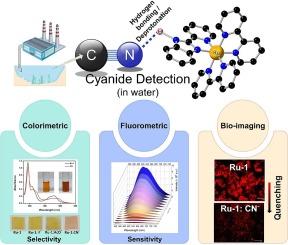
A pyridyl-benzimidazole based ruthenium(II) complex as optical sensor: Targeted cyanide detection and live cell imaging applications.
S. Naithani, F. Thetiot, V. Yadav, S. Saini, P. Roy, S. Layek, T. Goswami, S. Kumar
Journal of Photochemistry and Photobiology A: Chemistry 2024, 453, 115610, DOI: 10.1016/j.jphotochem.2024.115610
An extreme toxicity of cyanide (CN−) ion in diverse environmental media has encouraged significant attention for scheming well-organised molecular probes for its selective and sensitive detection. Keeping in mind, we present here a monometallic Ru(II) complex (Ru-1) based on 2-(pyridin-2-yl)-1H-benzo[d]imidazole moiety acting as a highly selective luminescent probe for CN− recognition in pure water. Besides, Ru-1 also acted as an efficient sensor for F−, AcO− and H2PO4− ions along with CN− when acetonitrile was chosen as solvent system. The binding constant (Kb) and detection limit (LoD) for CN− have been depicted as 3.05 × 106 M−1 and 12.8 nM, respectively, in water. The close proximity of N-H site with Ru(II) centre along with its remarkable acidity were identified as mainly responsible for the high selectivity of Ru-1 toward CN− in water. Job’s plot and DFT analyses were carried out to support the anion binding mechanism. Furthermore, the time-resolved fluorescence (TRF) spectroscopy was performed to assess the cyanide-induced emission lifetime change of Ru-1 in aqueous medium. In order to investigate applied potential, the probe Ru-1 was notably developed into paper-based strips that could readily detect CN− ion in mM range via naked eye under 365 nm light illumination, and also adequately employed to detect CN− in human breast cancer MCF-7 cell lines and natural food sources (such as apple seeds and sprouting potatoes).